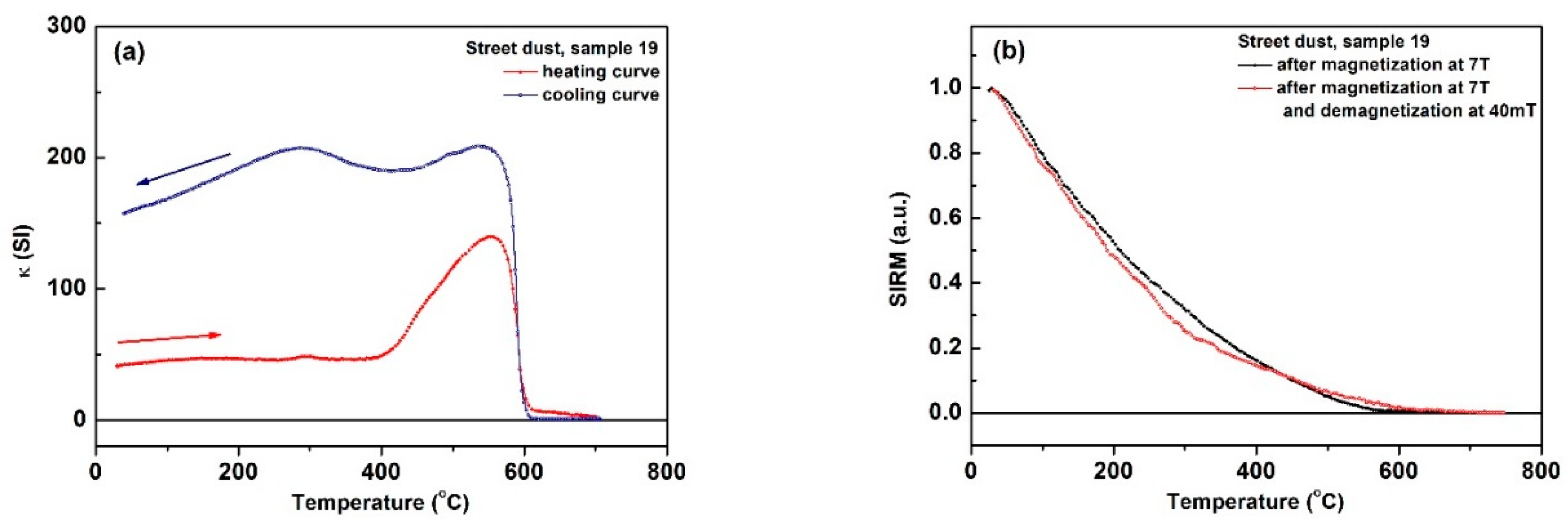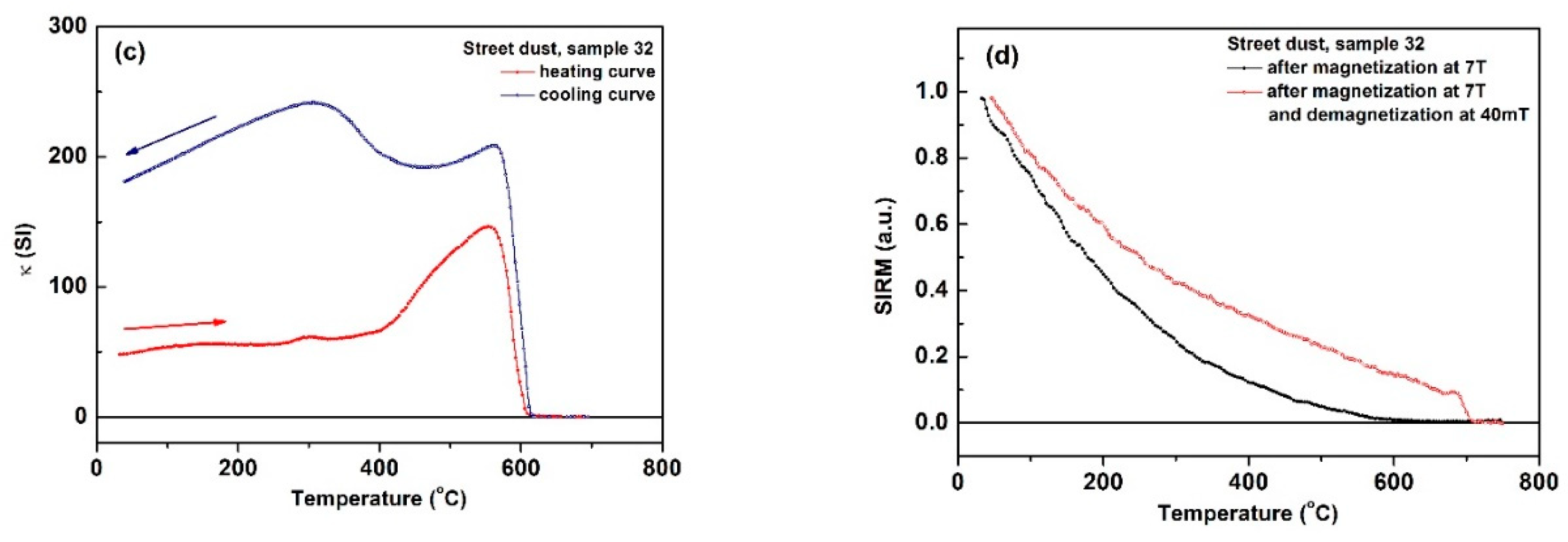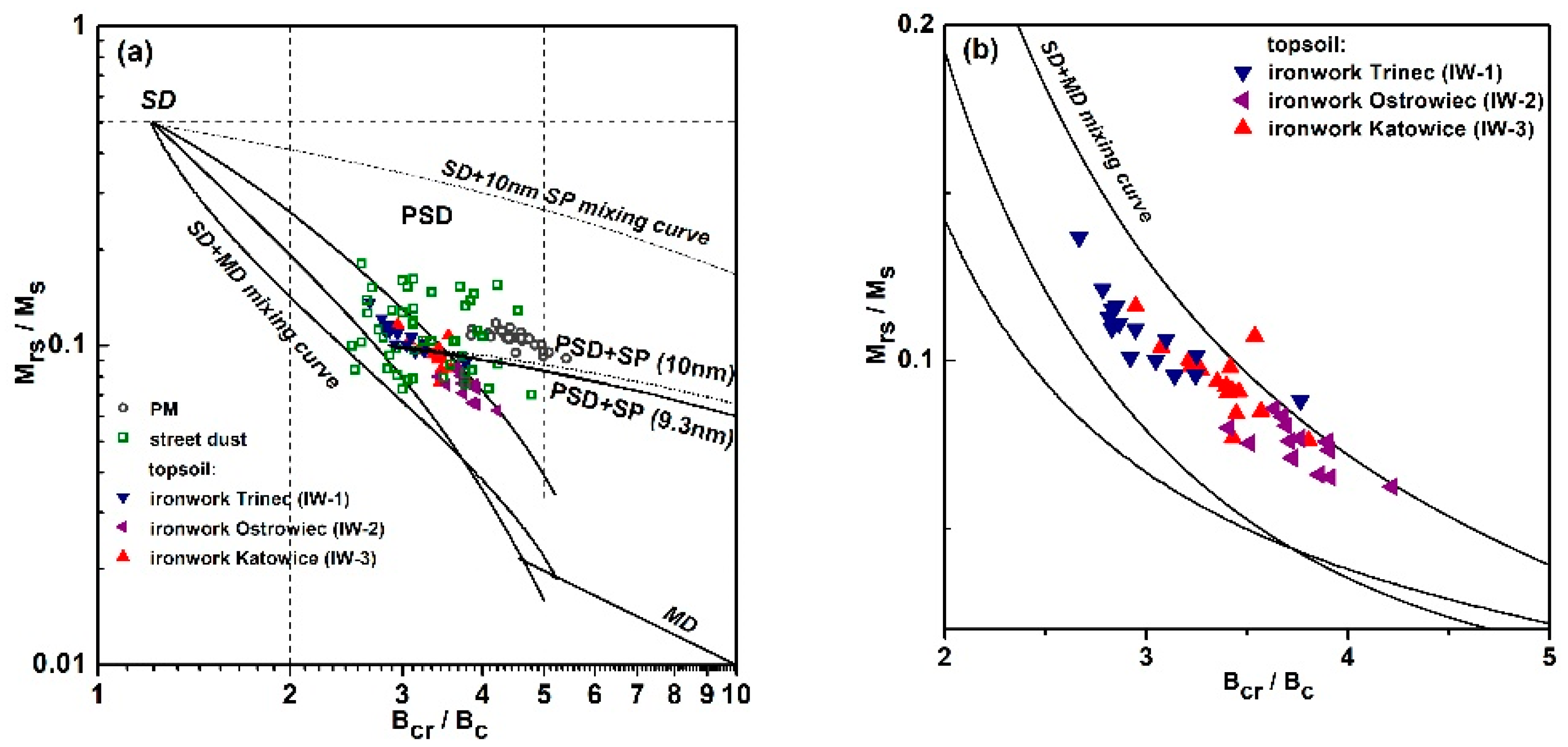Integrated Magnetic Analyses for the Discrimination of Urban and Industrial Dusts
Abstract
:1. Introduction
2. Materials and Methods
2.1. Topsoil Collected in the Vicinity of Ironworks
2.1.1. Sampling Area
2.1.2. Collection and Preparation of Topsoil Material
2.2. Street Dust
2.2.1. Sampling Area
2.2.2. Collection and Preparation of Street Dust Material
2.3. Particulate Matter
2.3.1. Sampling Area
2.3.2. Collection and Preparation of PM
2.4. Description of Magnetic Methods
2.4.1. Magnetic Susceptibility (χ), Anhysteretic Remanent Susceptibility (χARM), and S-ratio
2.4.2. Hysteresis Loops
2.4.3. IRM(B) Acquisition Curves and Component Analysis
2.4.4. FORC Diagrams
2.4.5. Thermomagnetic Curves of κ(T)
2.4.6. Thermomagnetic Curves of SIRM(T)
3. Results
3.1. Magnetic Mineralogy
3.1.1. Identification of Magnetic Minerals in Topsoil Polluted by Technogenic Particles Emitted by the Ironworks
3.1.2. Identification of Magnetic Minerals in Street Dust
3.1.3. Identification of Magnetic Minerals in PM
3.2. Magnetic Properties and Grain Size Analyses
4. Discussion
5. Conclusions
Supplementary Materials
Author Contributions
Funding
Acknowledgments
Conflicts of Interest
References
- Querol, X.; Alastuey, A.S.; Lopez-Soler, A.; Mantillai, E.; Plana, F. Mineral Composition of atmospheric particulates around a large coal-fired powerstation. Atmos. Environ. 1996, 30, 3557–3572. [Google Scholar] [CrossRef]
- Goddu, S.R.; Appel, E.; Jordanova, D.; Wehland, F. Magnetic properties of road dust from Visakhapatnam (India)-relationship to industrial pollution and road traffic. Phys. Chem. Earth 2004, 29, 985–995. [Google Scholar] [CrossRef]
- Jordanova, D.; Jordanova, N.; Hoffmann, V. Magnetic mineralogy and grain-size dependence of hysteresis parameters of single spherules from industrial waste products. Phys. Earth Planet. Inter. 2006, 154, 255–265. [Google Scholar] [CrossRef]
- Lu, S.G.; Bai, S.Q. Study on the correlation of magnetic properties and heavy metals content in urban soils of Hangzhou City, China. J. Appl. Geophys. 2006, 60, 1–12. [Google Scholar] [CrossRef]
- Hoffmann, V.; Knab, M.; Apple, E. Magnetic susceptibility mapping of roadside pollution. J. Geochem. Explor. 1999, 99, 313–326. [Google Scholar] [CrossRef]
- Hanesch, M.; Scholger, R.; Rey, D. Mapping dust distribution around an industrial site by measuring magnetic parameters of tree leaves. Atmos. Environ. 2003, 37, 5125–5133. [Google Scholar] [CrossRef]
- Yang, T.; Liu, Q.S.; Chan, L.S.; Cao, G.D. Magnetic investigation of heavy metals contamination in urban topsoils around the East Lake, Wuhan city, China. Geophys. J. Int. 2007, 171, 603–612. [Google Scholar] [CrossRef] [Green Version]
- Matzka, J.; Maher, B.A. Magnetic biomonitoring of roadside tree leaves: Identification of spatial and temporal variations in vehicle-derived particulates. Atmos. Environ. 1999, 3, 4565–4569. [Google Scholar] [CrossRef]
- Kim, W.; Doh, S.J.; Yu, Y. Anthropogenic contribution of magnetic particulates in urban roadside dust. Atmos. Environ. 2009, 43, 3137–3144. [Google Scholar] [CrossRef]
- Yang, T.; Liu, Q.; Li, H.; Zeng, Q.; Chan, L. Anthropogenic magnetic particles and heavy metals in the road dust: Magnetic identification and its implications. Atmos. Environ. 2010, 44, 1175–1185. [Google Scholar] [CrossRef]
- Bućko, M.S.; Magiera, T.; Johanson, B.; Petrovský, E.; Pesonen, L.J. Identification of magnetic particulates in road dust accumulated on roadside snow using magnetic, geochemical and micro-morphological analyses. Environ. Pollut. 2011, 159, 1266–1276. [Google Scholar] [CrossRef]
- Wawer, M.; Magiera, T.; Ojha, G.; Appel, E.; Kusza, G.; Hu, S.; Basavaiah, N. Traffic-related pollutants in roadside soils of different countries in Europe and Asia. Water Air Soil Pollut. 2015, 226, 216. [Google Scholar] [CrossRef]
- Ma, M.; Hu, S.; Wang, L.; Appel, E. The distribution process of traffic contamination on roadside surface and the influence of meteorological conditions revealed by magnetic monitoring. Environ. Monit. Assess 2016, 188, 650. [Google Scholar] [CrossRef] [PubMed]
- Łuczak, K.; Kusza, G. Magnetic susceptibility in the soils along communication routes in the town of Opole. J. Ecol. Eng. 2019, 20, 234–238. [Google Scholar]
- Magiera, T.; Jabłońska, M.; Strzyszcz, Z.; Rachwał, M. Morphological and mineralogical forms of technogenic magnetic particles in industrial dusts. Atmos. Environ. 2011, 45, 4281–4290. [Google Scholar] [CrossRef]
- Catinon, M.; Ayrault, S.; Boudouma, O.; Bordier, L.; Agnello, G.; Reynaud, S.; Tissut, M. Isolation of technogenic magnetic particles. Sci. Total Environ. 2014, 475, 39–47. [Google Scholar] [CrossRef] [PubMed]
- Kukier, U.; Ishak, C.F.; Sumner, M.E.; Miller, W.P. Composition and element solubility of magnetic and non-magnetic fly ash fractions. Environ. Pollut. 2003, 123, 255–266. [Google Scholar] [CrossRef]
- Gupta, S.; Dubikova, M.; French, D.; Sahajwalla, V. Characterization of the origin and distribution of the minerals and phases in metallurgical cokes. Energy Fuels 2007, 21, 303–313. [Google Scholar] [CrossRef]
- Flanders, P. Identifying fly ash at a distance from fossil fuel power stations. Environ. Sci. Technol. 1999, 33, 528–532. [Google Scholar] [CrossRef]
- Blaha, U.; Appel, E.; Stanjek, H. Determination of anthropogenic boundary depth in industrially polluted soil and semi-quantification of heavy metal loads using magnetic susceptibility. Environ. Pollut. 2008, 156, 278–289. [Google Scholar] [CrossRef]
- Magiera, T.; Kapička, A.; Petrovský, E.; Strzyszcz, Z.; Fialová, H.; Rachwał, M. Magnetic anomalies of forest soils in the Upper Silesia–Northern Moravia region. Environ. Pollut. 2008, 156, 618–627. [Google Scholar] [CrossRef] [PubMed]
- Sapkota, B.; Cioppa, M.T. Using magnetic and chemical measurements to detect atmospherically-derived metal pollution in artificial soils and metal uptake in plants. Environ. Pollut. 2012, 170, 131–144. [Google Scholar] [CrossRef] [PubMed]
- Xia, D.; Wang, B.; Yu, Y.; Jia, J.; Nie, Y.; Wang, X.; Xu, S. Combination of magnetic parameters and heavy metals to discriminate soil-contamination sources in Yinchuan—A typical oasis city of Northwestern China. Sci. Total Environ. 2014, 485, 83–92. [Google Scholar] [CrossRef]
- Bućko, M.S.; Magiera, T.; Pesonen, L.J.; Janus, B. Magnetic, geochemical, and microstructural characteristics of road dust on roadsides with different traffic volumes—Case study from Finland. Water Air Soil Pollut. 2010, 209, 295–306. [Google Scholar] [CrossRef]
- Grigoratos, T.; Martini, G. Brake wear particle emissions: A review. Environ. Sci. Pollut. Res. 2015, 22, 2491–2504. [Google Scholar] [CrossRef] [PubMed] [Green Version]
- Ojha, G.; Appel, E.; Wawer, M.; Magiera, T. Monitoring-based discrimination of pathways of traffic-derived pollutants. Stud. Geophys. Geod. 2015, 59, 594–613. [Google Scholar] [CrossRef]
- Górka-Kostrubiec, B.; Werner, T.; Dytłow, S.; Szczepaniak-Wnuk, I.; Jeleńska, M.; Hanc-Kuczkowska, A. Detection of metallic iron in urban dust by using high-temperature measurements supplemented with microscopic observations and Mössbauer spectra. J. Appl. Geophys. 2019, 166, 89–102. [Google Scholar] [CrossRef]
- Dytłow, S.; Winkler, A.; Górka-Kostrubiec, B.; Sagnotti, L. Magnetic, geochemical and granulometric properties of street dust from Warsaw (Poland). J. Appl. Geophys. 2019, 169, 58–73. [Google Scholar] [CrossRef]
- Winkler, A.; Contardo, T.; Vannini, A.; Sorbo, S.; Basile, A.; Loppi, S. Magnetic emissions from brake wear are the major source of airborne particulate matter bioaccumulated by lichens exposed in Milan (Italy). Appl. Sci. 2020, 10, 2073. [Google Scholar] [CrossRef] [Green Version]
- Gonet, T.; Maher, B.A.; Kukutschová, J. Source apportionment of magnetite particles in roadside airborne particulate matter. Sci. Total Environ. 2020, 752, 141828. [Google Scholar] [CrossRef]
- Spassov, S.; Egli, R.; Heller, F.; Nourgaliev, D.K.; Hannam, J. Magnetic quantification of urban pollution sources in atmospheric particulate matter. Geophys. J. Int. 2004, 159, 555–564. [Google Scholar] [CrossRef] [Green Version]
- Cui, Y.; Verosub, K.L.; Roberts, A.P. The effect of low-temperature oxidation on large multi-domain magnetite. Geophys. Res. Lett. 1994, 21, 757–760. [Google Scholar] [CrossRef]
- Van Velzen, A.J.; Dekkers, M.J. Low-temperature oxidation of magnetite in loess-paleosol sequences: A correction of rock magnetic parameters. Stud. Geophys. Geod. 1999, 43, 357–375. [Google Scholar] [CrossRef]
- Roberts, A.P.; Tauxe, L.; Heslop, D.; Zhao, X.; Jiang, Z. A critical appraisal of the “Day” diagram. J. Geophys. Res. Solid Earth 2018, 123, 2618–2644. [Google Scholar] [CrossRef]
- Kim, W.; Doh, S.J.; Park, Y.H.; Yun, S.T. Two-year magnetic monitoring in conjunction with geochemical and electron microscopic data of roadside dust in Seoul, Korea. Atmos. Environ. 2007, 41, 7627–7641. [Google Scholar] [CrossRef]
- Zheng, Y.; Zhang, S. Magnetic properties of street dust and topsoil in Beijing and its environmental implications. Chin. Sci. Bull. 2008, 53, 408–417. [Google Scholar] [CrossRef]
- Sagnotti, L.; Taddeucci, J.; Winkler, A.; Cavallo, A. Compositional, morphological, and hysteresis characterization of magnetic airborne particulate matter in Rome, Italy. Geochem. Geophys. Geosyst. 2009, 10. [Google Scholar] [CrossRef]
- Jaishankar, M.; Tseten, T.; Anbalagan, N.; Mathew, B.B.; Beeregowda, K.N. Toxicity: Mechanism and health effects of some heavy metals. Interdiscip. Toxicol. 2014, 7, 60–72. [Google Scholar] [CrossRef] [Green Version]
- Janssen, N.A.; Hoek, G.; Simic-Lawson, M.; Fischer, P.; van Bree, L.; ten Brink, H.; Keuken, M.; Atkinson, R.W.; Anderson, H.R.; Brunekreef, B.; et al. Black carbon as an additional indicator of the adverse health effects of airborne particles compared with PM10 and PM2.5. Environ. Health Perspect. 2011, 119, 1691–1699. [Google Scholar] [CrossRef] [Green Version]
- Maher, B.A.; Ahmed, I.A.; Karloukovski, V.; MacLaren, D.A.; Foulds, P.G.; Allsop, D.; Manne, D.M.A.; Torres-Jardón, R.; Calderon-Garciduenas, L. Magnetite pollution nanoparticles in the human brain. Proc. Natl. Acad. Sci. USA 2016, 113, 10797–10801. [Google Scholar] [CrossRef] [Green Version]
- Calderón-Garcidueñas, L.; González-Maciel, A.; Mukherjee, P.S.; Reynoso-Robles, R.; Pérez-Guillé, B.; Gayosso-Chávez, C.; Torres-Jardón, R.; Cross, J.V.; Ahmed, I.A.M.; Karloukovski, V.V.; et al. Combustion- and friction-derived magnetic air pollution nanoparticles in human hearts. Environ. Res. 2019, 76, 108567. [Google Scholar] [CrossRef] [PubMed]
- Day, R.; Fuller, M.; Schmidt, V.A. Hysteresis properties of titanomagnetites: Grain-size and compositional dependence. Phys. Earth Planet. Inter. 1977, 13, 260–267. [Google Scholar] [CrossRef]
- Dunlop, D.J. Theory and application of the Day plot (Mrs/Ms versus Hcr/Hc) 1. Theoretical curves and tests using titanomagnetite data. J. Geophys. Res. Solid Earth 2002, 107, 2056. [Google Scholar] [CrossRef] [Green Version]
- Dunlop, D.J. Theory and application of the Day plot (Mrs/Ms versus Hcr/Hc) 2. Application to data for rocks, sediments, and soils. J. Geophys. Res. Solid Earth 2002, 107, 2057. [Google Scholar] [CrossRef] [Green Version]
- Pike, C.R.; Roberts, A.P.; Verosub, K.L. Characterizing interactions in fine magnetic particle systems using first order reversal curves. J. Appl. Phys. 1999, 85, 6660–6667. [Google Scholar] [CrossRef] [Green Version]
- Roberts, A.P.; Pike, C.R.; Verosub, K.L. First-order reversal curve diagrams: A new tool for characterizing the magnetic properties of natural samples. J. Geophys. Res. 2000, 105, 2847–28461. [Google Scholar] [CrossRef]
- Roberts, A.P.; Heslop, D.; Zhao, X.; Pike, C.R. Understanding fine magnetic particle systems through use of first-order reversal curve diagrams. Rev. Geophys. 2014, 52, 557–602. [Google Scholar] [CrossRef]
- Warsaw City Hall Comunity Office, Szacunek Ludności i Kierunki Mobilności—Raport z Badania. Available online: https://www.um.warszawa.pl/o-warszawie/warszawa-w-liczbach/szacunek-ludno-ci-i-kierunki-mobilno-ci (accessed on 7 October 2020).
- PGNiG TERMIKA Offcial Website. Available online: https://termika.pgnig.pl (accessed on 7 October 2020).
- Thompson, R.; Oldfield, F. Environmental Magnetism; Allen and Unwin: London, UK, 1986. [Google Scholar]
- Evans, M.E.; Heller, F. Environmental Magnetism: Principles and Applications of Environmagnetics; Academic Press: Oxford, UK, 2003. [Google Scholar]
- Liu, Q.; Roberts, A.; Torrent, J.; Horng, C.S. What do the HIRM and S-ratio really measure in environmental magnetism? Geochem. Geophys. Geosyst. 2007, 8, Q09011. [Google Scholar] [CrossRef]
- Maher, B. Characterization of soils by mineral magnetic measurements. Phys. Earth Planet. Inter. 1986, 42, 76–92. [Google Scholar] [CrossRef]
- Kruiver, P.P.; Dekkers, M.J.; Heslop, D. Quantification of magnetic coercivity components by the analysis of acquisition curves of isothermal remanent magnetization. Earth Planet. Sci. Lett. 2001, 89, 269–276. [Google Scholar] [CrossRef]
- Harrison, R.J.; Feinberg, J.M. FORCinel: An Improved algorithm for calculating first-order reversal curve distributions using locally weighted regression smoothing. Geochem. Geophys. Geosyst. 2008, 9, Q05016. [Google Scholar] [CrossRef]
- Egli, R.; Florindo, F.; Roberts, A.P. Introduction to magnetic iron minerals in sediments and their relation to geologic processes, climate, and the geomagnetic field. Glob. Planet. Chang. 2013, 110, 259–263. [Google Scholar] [CrossRef]
- Tauxe, L. Paleomagnetic Principles and Practice; Kluwer Academic Publishers: Dordrecht, The Netherlands, 1998. [Google Scholar]
- Kądziałko-Hofmokl, M.; Kruczyk, J. Complete and partial self-reversal of natural remanent magnetization in basaltic rocks from Lower Silesia. Pure Appl. Geophys. 1976, 114, 207–213. [Google Scholar] [CrossRef]
- Dunlop, D.; Özdemir, Ö. Rock Magnetism: Fundamentals and Frontiers; Cambridge University Press: Cambridge, UK, 1997. [Google Scholar] [CrossRef]
- Muxworthy, A.R.; Schmidbauer, E.; Petersen, N. Magnetic properties and Mössbauer spectra of urban atmospheric particulate matter: A case study from Munich, Germany. Geophys. J. Int. 2002, 150, 558–570. [Google Scholar] [CrossRef] [Green Version]
- Zhang, C.; Qiao, Q.; Piper, J.D.A.; Huang, B. Assessment of heavy metal pollution from a Fe-smelting plant in urban river sediments using environmental magnetic and geochemical methods. Environ. Pollut. 2011, 159, 3057–3070. [Google Scholar] [CrossRef]
- Górka-Kostrubiec, B.; Szczepaniak-Wnuk, I. Magnetic study of a mixture of magnetite and metallic iron in indoor dust samples. Air Qual. Atmos. Health 2017, 10, 105–116. [Google Scholar] [CrossRef] [Green Version]
- King, J.; Banerjee, S.K.; Marvin, J.; Özdemir, Ö. A comparison of different magnetic methods for determining the relative grain size of magnetite in natural materials: Some results from lake sediments. Earth Planet. Sci. Lett. 1982, 59, 404–419. [Google Scholar] [CrossRef]
- Moskowitz, B. Hitchhiker’s Guide to Magnetism. 2007. Available online: http://www.irm.umn.edu/hg2m/hg2m.pdf (accessed on 30 March 2019).
- Szuszkiewicz, M.; Magiera, T.; Kapička, A.; Petrovský, E.; Grison, H.; Gołuchowska, B. Magnetic characteristics of industrial dust from different sources of emission: A case study of Poland. J. Appl. Geophys. 2015, 16, 84–92. [Google Scholar] [CrossRef]
- Bloemendal, J.; King, J.W.; Hall, F.R.; Doh, S.J. Rock magnetism of late Neogene and Pleistocene deep-sea sediments: Relationship to sediment source, diagenetic processes, and sediment lithology. J. Geophys. Res. 1992, 97, 4361–4375. [Google Scholar] [CrossRef]
- Zhou, H.Y.; Wang, X.S.; Shan, A.Q. Discriminating soil-contamination sources using combination of magnetic parameters. Environ. Earth Sci. 2015, 74, 5805–5811. [Google Scholar] [CrossRef]
- Roberts, A.P.; Liu, Q.; Rowan, C.J.; Chang, L.; Carvallo, C.; Torrent, J.; Horng, C.S. Characterization of hematite (a-Fe2O3), goethite (a-FeOOH), greigite (Fe3S4), and pyrrhotite (Fe7S8) using first-order reversal curve diagrams. J. Geophys. Res. 2006, 111, B12S35. [Google Scholar] [CrossRef]
- Ahmadzadeh, M.; Romero, C.; McCloy, J. Magnetic analysis of commercial hematite, magnetite, and their mixtures. AIP Adv. 2018, 8, 056807. [Google Scholar] [CrossRef] [Green Version]
- Górka-Kostrubiec, B. The magnetic properties of indoor dust fractions as markers of air pollution inside buildings. Build. Environ. 2015, 90, 186–195. [Google Scholar] [CrossRef]
- Jeleńska, M.; Górka-Kostrubiec, B.; Werner, T.; Kądziałko-Hofmokl, M.; Szczepaniak-Wnuk, I.; Gonet, T.; Szwarczewski, P. Evaluation of indoor/outdoor urban air pollution by magnetic, chemical and microscopic studies. Atmos. Pollut. Res. 2017, 8, 754–766. [Google Scholar] [CrossRef]
- Sagnotti, L.; Macrì, P.; Egli, R.; Mondino, M. Magnetic properties of atmospheric particulate matter from automatic air sampler stations in Latium (Italy): Toward a definition of magnetic fingerprints for natural and anthropogenic PM sources. J. Geophys. Res. 2006, 111, B12S22. [Google Scholar] [CrossRef]
- Sagnotti, L.; Winkler, A. On the magnetic characterization and quan-tification of the superparamagnetic fraction of traffic-related urban airborne PM in Rome, Italy. Atmos. Environ. 2012, 59, 131–140. [Google Scholar] [CrossRef]















| Type of Dust | Sampling Location | Number of Samples | Period of Collecting | Description of Collecting Method |
|---|---|---|---|---|
| Ironworks Třinec (IW-1) | Topsoil from the uppermost 30 cm of forest soil core collected by HUMAX SH 300 sampler. Topsoil samples were taken from the layers exhibiting the highest magnetic susceptibility, i.e., from the layers mostly accumulated technogenic magnetic particles. | |||
| Industrial dust from steel production, | Třinec, Czech Republic, Northern Moravia | 18 topsoil samples | May 2018 | |
| Ironworks Ostrowiec (IW-2) | ||||
| Industrial dust from steel production | Ostrowiec Świętokrzyski, Poland, Holy Cross Province | 13 topsoil samples | May 2018 | |
| Ironworks Katowice (IW-3) | ||||
| Industrial dust from steel production | Dąbrowa Górnicza, Poland, Silesia Province | 16 topsoil samples | May 2018 | |
| Street dust | ||||
| Urban dust from traffic-related sources | Warsaw, Poland, Masovia Region | 70 dust samples | June–July 2013 | Dust was collected from an area measuring about 1 m2 of the road surface using a clean plastic brush and dustpan |
| Particulate matter | ||||
| Atmospheric dust from the urban area. | Warsaw, Poland, Masovia Region | 28 filters collected in one location | From December 2018 to April 2019 | PM with a particle diameter of <10 μm was collected on glass filters by the low-volume air samplers. PM was collected on each filter for 72 h (3 days) |
| Component 1 | Component 2 | Component 3 | |
|---|---|---|---|
| Ironworks Třinec (IW-1) | |||
| Contribution (%) | 86 ± 6 | 8 ± 4 | 5 ± 2 |
| B1/2 (mT) | 44.9 ± 1.7 | 160 ± 80 | 17.3 ±1.1 |
| DP (mT) | 0.33 ± 0.01 | 0.59 ± 0.13 | 0.16 ± 0.02 |
| Ironworks Ostrowiec (IW-2) | |||
| Contribution (%) | 94 ± 2 | 5 ± 1 | |
| B1/2 (mT) | 49.4 ± 2.3 | 400 ± 200 | |
| DP (mT) | 0.32 ± 0.01 | 0.75 ± 0.06 | |
| Ironworks Katowice (IW-3) | |||
| Contribution (%) | 90 ± 3 | 10 ± 3 | |
| B1/2 (mT) | 50.5 ± 2.8 | 440 ± 285 | |
| DP (mT) | 0.32 ± 0.01 | 0.75 ± 0.03 | |
Publisher’s Note: MDPI stays neutral with regard to jurisdictional claims in published maps and institutional affiliations. |
© 2020 by the authors. Licensee MDPI, Basel, Switzerland. This article is an open access article distributed under the terms and conditions of the Creative Commons Attribution (CC BY) license (http://creativecommons.org/licenses/by/4.0/).
Share and Cite
Górka-Kostrubiec, B.; Magiera, T.; Dudzisz, K.; Dytłow, S.; Wawer, M.; Winkler, A. Integrated Magnetic Analyses for the Discrimination of Urban and Industrial Dusts. Minerals 2020, 10, 1056. https://doi.org/10.3390/min10121056
Górka-Kostrubiec B, Magiera T, Dudzisz K, Dytłow S, Wawer M, Winkler A. Integrated Magnetic Analyses for the Discrimination of Urban and Industrial Dusts. Minerals. 2020; 10(12):1056. https://doi.org/10.3390/min10121056
Chicago/Turabian StyleGórka-Kostrubiec, Beata, Tadeusz Magiera, Katarzyna Dudzisz, Sylwia Dytłow, Małgorzata Wawer, and Aldo Winkler. 2020. "Integrated Magnetic Analyses for the Discrimination of Urban and Industrial Dusts" Minerals 10, no. 12: 1056. https://doi.org/10.3390/min10121056
APA StyleGórka-Kostrubiec, B., Magiera, T., Dudzisz, K., Dytłow, S., Wawer, M., & Winkler, A. (2020). Integrated Magnetic Analyses for the Discrimination of Urban and Industrial Dusts. Minerals, 10(12), 1056. https://doi.org/10.3390/min10121056







